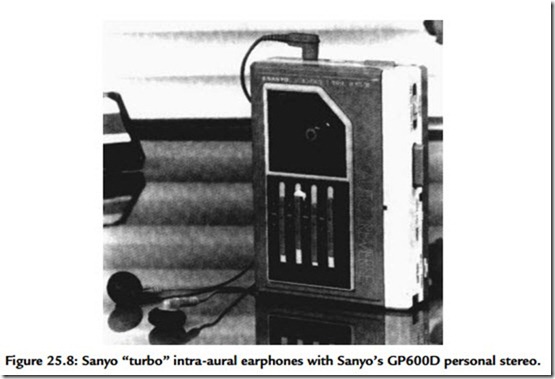Measuring Headphones
Both types of headphone work into an entirely artificial environment in which the close proximity of the diaphragm and, in the case of the closed headphone, a trapped volume of
air, modifies the frequency response as perceived by the ear. This situation is additionally confused by the fact that each person’s ears are different in shape and at high frequencies will introduce their own pattern of reflections, causing reinforcements and cancellations at different frequencies. Measuring headphones with artificial ears reveals some pretty horrifying curves, but the results on the heads of real listeners are equally alarming.
The fact of the matter is that even if a headphone were made to measure “flat” on a person’s head as measured inside the cavity at the entrance to the ear, the headphone would not sound right. This is quite simply because, even when listening without headphones, the sound pressure response at this point, in the ear canal, at the eardrum, or wherever you care to measure it, is simply not flat. We are not dealing with an amplifier or an electromechanical transducer but the human ear. The ear and brain have of course figured out that the normally complex pattern of reflections and cancellations with which it has to continually deal are perfectly natural and they sound that way.
Unfortunately, each individual’s ears make their own different imprint, but there are some rough trends that can be observed. For instance, there is generally a 2-kHz to 5-kHz boost, a dip around 8 kHz, and all sorts of peaks and dips above 8 kHz. For a natural sound balance with headphones, they should produce measurements that follow this rough trend when tested on real ears. However, measurements carried out using headphones on real ears or artificial ears (designed to mimic real ears for the purposes of testing) reveal differing results that can only be interpreted by the experienced observer. It is clear, though, that published response graphs of headphones should be taken with a very large pinch of salt.
The Future
Guessing on the future is always impossible—one can only be guided by current trends, which are unavoidably based on the past! It is very difficult to see how headphones will develop. New principles of operation are unlikely to spring out of nowhere. Just about all the likely candidates of moving air have been exploited. However, as with the high polymer headphone, the invention of new, better materials can often turn a previously impossible type of headphone into a reality. It is consequently unlikely that tomorrow’s headphones will be anything other than developments of today’s (unless it becomes possible to inject the audio signals, suitably coded by digital techniques, directly into the auditory nerve or brain).
That may be highly unlikely, not to say impractical and unnecessary, but digital technology could play a part in equalizing the response of headphones. For instance, it is possible to equalize the headphone signal so that the response at the ears when using headphones more closely mimics the headphone-less characteristic. It would be possible to undertake this equalization digitally to exactly compensate for each individual and give improved sound quality. At present this would be fairly expensive, but with processing power falling it should not be long before it is viable commercially. The technology already exists.
Likewise it is perfectly feasible to build digital filters that compensate for each individual’s head-baffle effect, thus converting stereo into dummy-head binaural sound for headphone listening. This could all be done at the same time as the earphone-response correction outlined earlier. The only question marks are the very limited market for such equipment and the high cost of developing it. The two conflicting sides (development costs versus economies of manufacturing scale) may not add up to a very balanced equation now, but who knows about the future?
Finally, the diaphragm itself may be driven not by analogue but directly using digital signals. This is not nearly so far-fetched as it sounds. With compact disc as the source, and given the transducer technology, it would be perfectly feasible to retain the signals in digital form from microphone to headphone, with any filtering or correction (as outlined earlier) carried out without the signal having to leave the digital domain.
Guess work may be way off beam, but there is one thing that is certain. There is a great future ahead for headphones.
